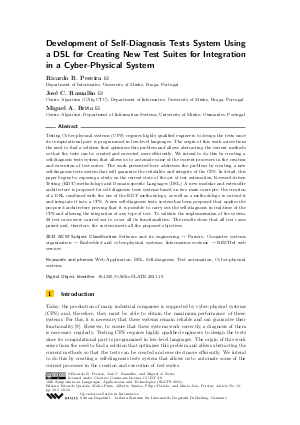Development of Self-Diagnosis Tests System Using a DSL for Creating New Test Suites for Integration in a Cyber-Physical System
Authors Ricardo B. Pereira, José C. Ramalho, Miguel A. Brito
-
Part of:
Volume:
10th Symposium on Languages, Applications and Technologies (SLATE 2021)
Part of: Series: Open Access Series in Informatics (OASIcs)
Part of: Conference: Symposium on Languages, Applications and Technologies (SLATE) - License:
 Creative Commons Attribution 4.0 International license
Creative Commons Attribution 4.0 International license
- Publication Date: 2021-08-10
File

PDF
OASIcs.SLATE.2021.19.pdf
- Filesize: 0.63 MB
- 16 pages
Document Identifiers
Subject Classification
ACM Subject Classification
- Software and its engineering → Parsers
- Computer systems organization → Embedded and cyber-physical systems
- Information systems → RESTful web services
Keywords
- Web Application
- DSL
- Self-diagnosis
- Test automation
- Cyber-physical systems
Metrics
- Access Statistics
-
Total Accesses (updated on a weekly basis)
0Document
0Metadata
Abstract
Testing Cyber-physical systems (CPS) requires highly qualified engineers to design the tests since its computational part is programmed in low-level languages. The origin of this work arises from the need to find a solution that optimizes this problem and allows abstracting the current methods so that the tests can be created and executed more efficiently. We intend to do this by creating a self-diagnosis tests system that allows us to automate some of the current processes in the creation and execution of test suites. The work presented here addresses the problem by creating a new self-diagnosis tests system that will guarantee the reliability and integrity of the CPS. In detail, this paper begins by exposing a study on the current state of the art of test automation, Keyword-driven Testing (KDT) methodology and Domain-specific Languages (DSL). A new modular and extensible architecture is proposed for self-diagnosis tests systems based on two main concepts: the creation of a DSL combined with the use of the KDT methodology, as well as a methodology to extend it and integrate it into a CPS. A new self-diagnosis tests system has been proposed that applies the proposed architecture proving that it is possible to carry out the self-diagnosis in real-time of the CPS and allowing the integration of any type of test. To validate the implementation of the system, 28 test cases were carried out to cover all its functionalities. The results show that all test cases passed and, therefore, the system meets all the proposed objectives.
Cite As Get BibTex
Ricardo B. Pereira, José C. Ramalho, and Miguel A. Brito. Development of Self-Diagnosis Tests System Using a DSL for Creating New Test Suites for Integration in a Cyber-Physical System. In 10th Symposium on Languages, Applications and Technologies (SLATE 2021). Open Access Series in Informatics (OASIcs), Volume 94, pp. 19:1-19:16, Schloss Dagstuhl – Leibniz-Zentrum für Informatik (2021)
https://doi.org/10.4230/OASIcs.SLATE.2021.19
BibTex
@InProceedings{pereira_et_al:OASIcs.SLATE.2021.19,
author = {Pereira, Ricardo B. and Ramalho, Jos\'{e} C. and Brito, Miguel A.},
title = {{Development of Self-Diagnosis Tests System Using a DSL for Creating New Test Suites for Integration in a Cyber-Physical System}},
booktitle = {10th Symposium on Languages, Applications and Technologies (SLATE 2021)},
pages = {19:1--19:16},
series = {Open Access Series in Informatics (OASIcs)},
ISBN = {978-3-95977-202-0},
ISSN = {2190-6807},
year = {2021},
volume = {94},
editor = {Queir\'{o}s, Ricardo and Pinto, M\'{a}rio and Sim\~{o}es, Alberto and Portela, Filipe and Pereira, Maria Jo\~{a}o},
publisher = {Schloss Dagstuhl -- Leibniz-Zentrum f{\"u}r Informatik},
address = {Dagstuhl, Germany},
URL = {https://drops.dagstuhl.de/entities/document/10.4230/OASIcs.SLATE.2021.19},
URN = {urn:nbn:de:0030-drops-144367},
doi = {10.4230/OASIcs.SLATE.2021.19},
annote = {Keywords: Web Application, DSL, Self-diagnosis, Test automation, Cyber-physical systems}
}
Author Details
- Centro Algoritmi (CAlg-CTC), Department of Informatics, University of Minho, Braga, Portugal
References
- Márcio Filipe Alves Carvalho. Automatização de testes de software, 2010. URL: https://files.isec.pt/DOCUMENTOS/SERVICOS/BIBLIO/teses/Tese_Mest_Marcio-Carvalho.pdf.
- S. Ciraci, J. C. Fuller, J. Daily, A. Makhmalbaf, and D. Callahan. A runtime verification framework for control system simulation. In 2014 IEEE 38th Annual Computer Software and Applications Conference, pages 75-84, 2014. URL: https://doi.org/10.1109/COMPSAC.2014.14.
- Guru99. What is automation testing?, 2021. URL: https://www.guru99.com/automation-testing.html.
- R. Hametner, D. Winkler, and A. Zoitl. Agile testing concepts based on keyword-driven testing for industrial automation systems. In IECON 2012 - 38th Annual Conference on IEEE Industrial Electronics Society, pages 3727-3732, 2012. URL: https://doi.org/10.1109/IECON.2012.6389298.
- Felienne Hermans, Martin Pinzger, and Arie Van Deursen. Domain-specific languages in practice: A user study on the success factors. In Lecture Notes in Computer Science (including subseries Lecture Notes in Artificial Intelligence and Lecture Notes in Bioinformatics), 2009. URL: https://doi.org/10.1007/978-3-642-04425-0_33.
- Jingfan Tang, Xiaohua Cao, and A. Ma. Towards adaptive framework of keyword driven automation testing. In 2008 IEEE International Conference on Automation and Logistics, pages 1631-1636, 2008. URL: https://doi.org/10.1109/ICAL.2008.4636415.
- Tomaž Kosar, Sudev Bohra, and Marjan Mernik. Domain-Specific Languages: A Systematic Mapping Study. Information and Software Technology, 2016. URL: https://doi.org/10.1016/j.infsof.2015.11.001.
- Charles W. Krueger. Software Reuse. ACM Computing Surveys (CSUR), 1992. URL: https://doi.org/10.1145/130844.130856.
- Edward A. Lee. Cyber physical systems: Design challenges. In Proceedings - 11th IEEE Symposium on Object/Component/Service-Oriented Real-Time Distributed Computing, ISORC 2008, 2008. URL: https://doi.org/10.1109/ISORC.2008.25.
- Marjan Mernik, Jan Heering, and Anthony M. Sloane. When and how to develop domain-specific languages. ACM Computing Surveys, 2005. URL: https://doi.org/10.1145/1118890.1118892.
- Jens Palsberg and C. Barry Jay. The essence of the Visitor pattern. In Proceedings - International Computer Software and Applications Conference, 1998. URL: https://doi.org/10.1109/CMPSAC.1998.716629.
- T. J. Parr and R. W. Quong. ANTLR: A predicated‐LL(k) parser generator. Software: Practice and Experience, 1995. URL: https://doi.org/10.1002/spe.4380250705.
- Terence Parr and Kathleen Fisher. LL(*): The foundation of the ANTLR parser generator. In Proceedings of the ACM SIGPLAN Conference on Programming Language Design and Implementation (PLDI), 2011. URL: https://doi.org/10.1145/1993498.1993548.
- Terence Parr, Sam Harwell, and Kathleen Fisher. Adaptive LL(*) parsing. ACM SIGPLAN Notices, 2014. URL: https://doi.org/10.1145/2714064.2660202.
- Gabriele Tomassetti. The antlr mega tutorial, 2021. URL: https://tomassetti.me/antlr-mega-tutorial/.
- X. Zhou, X. Gou, T. Huang, and S. Yang. Review on testing of cyber physical systems: Methods and testbeds. IEEE Access, 6:52179-52194, 2018. URL: https://doi.org/10.1109/ACCESS.2018.2869834.
